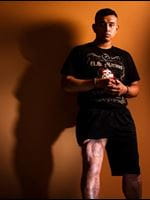Research Shows Promise of Restoring Damaged Muscles and Limbs
Initial studies have focused on the use of small intestinal submucosa (SIS) scaffolds to replace partial lost calf muscle and Achilles tendon.
These studies have shown that SIS is able to stimulate restoration of:
- Major muscle mass.
- Functionality to the junction between the muscle and tendon of a damaged limb.
This new muscle growth includes a mixed muscle fiber type much like the lost native muscle. It's able to both contract and react to nerve impulses.
McGowan Institute researchers in muscle tissue regrowth include:
ECM Scaffold Implant for Reconstituting Functional Musculotendinous Tissue
Massive loss of musculotendinous tissue from trauma leads to serious pain and anguish.
Surgical repair of such injuries is challenging. If surgery doesn't work, it can even lead to amputation of the affected limb.
A loss of tissue mass in the gastrocnemius muscle, quadriceps, biceps, triceps, or hamstring muscle group can pose surgical challenges.
When primary repair is impossible due to loss of tissue domain, doctors have tried:
- Free muscle grafts
- Pedicle grafts
- Prosthetic materials
The results of such efforts are often much less than satisfactory.
Autologous grafts compound the post-surgical problems and reduces a patient's quality of life.
There are limited existing treatment options for loss of large masses of muscle tissue domain.
Regenerative medicine that could restore functional muscle-tendon tissue, nerves, and blood vessels would be an ideal treatment of traumatic tissue injury.
Research on Using an ECM Scaffold Implant to Restore Tissue
A study led by Stephen Badylak, MD, and J. Peter Rubin, MD, FACS, at the McGowan Institute for Regenerative Medicine proposes using an “off the shelf” biologic scaffold material that would:
- Replace the missing soft tissue.
- Initiate a stem/progenitor cell recruitment process.
- Help restore site appropriate functional tissue.
Tissue engineering of lost muscle due to injury uses extracellular matrix (ECM).
ECM is a natural material with structural proteins that provide mechanical strength and structural support. It also has functional molecules with diverse bioactive properties.
With the addition of aggressive regenerative rehab protocols immediately after surgical implantation of an ECM scaffold to an area of volumetric muscle loss results in significant benefits for ECM remodeling.
Rehab exercises likely provide the needed mechanical signals to encourage cell migration and site-specific differentiation in the temporal framework required for constructive remodeling.
ECM Clinical Trial Results
The ECM clinical trial was a multidisciplinary endeavor. Fusion of the clinical and rehab expertise with tissue engineering and regenerative medicine technologies led to the incredible outcomes shared below.
 Marine Corporal Isaias Hernandez (photographed by Scott Lewis, Discover Magazine), then 19, got injured by shrapnel when an enemy mortar exploded nearby.
Marine Corporal Isaias Hernandez (photographed by Scott Lewis, Discover Magazine), then 19, got injured by shrapnel when an enemy mortar exploded nearby.
“Pretty much anything that wasn’t covered — arms and legs — was hit,” he said.
Worst hit was his upper right leg, which was so damaged he could hardly use it.
After multiple surgeries using traditional procedures, Corporal Hernandez was considering having the leg amputated. He thought he could function better with a prosthetic leg.
Instead, he had the chance to take part in the ECM-based therapy trial. Today, he rides mountain bikes and takes part in other rigorous activities.
Sergeant Ron Strang was a Marine with a huge divot in his upper thigh where the quadriceps muscle had been. A roadside bomb in Afghanistan blew off part of Sergeant Strang’s left thigh.

Taking part in the ECM clinical trial allowed Sergeant Strang to:
- Grow new muscle.
- Walk easily and run on a treadmill.
- Think of a post-military career as a police officer.
Early results with Sergeant Strang and some other patients showed that the animal scaffolding was spurring muscle growth.
“We are seeing evidence of remodeling of tissues,” Dr. Rubin said.
Learn more about regenerative medicine
To learn more about ECM to reconstitute functional musculotendinous tissue, contact the UPMC Department of Plastic Surgery at 1-877-639-9688.
















 Marine Corporal Isaias Hernandez (photographed by Scott Lewis, Discover Magazine), then 19, got injured by shrapnel when an enemy mortar exploded nearby.
Marine Corporal Isaias Hernandez (photographed by Scott Lewis, Discover Magazine), then 19, got injured by shrapnel when an enemy mortar exploded nearby.
